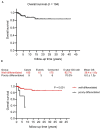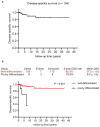Survival Outcomes and Prognostic Predictors in Patients With Malignant Struma Ovarii
- PMID: 35004743
- PMCID: PMC8733601
- DOI: 10.3389/fmed.2021.774691
Survival Outcomes and Prognostic Predictors in Patients With Malignant Struma Ovarii
Abstract
Background: Malignant struma ovarii (MSO) is an extremely rare ovarian malignant tumor and there is limited data on the survival outcomes and prognostic predictors of MSO. The objectives of this study were to investigate the disease-free survival (DFS), overall survival (OS), and disease-specific survival (DSS) rates of patients with MSO, and also evaluate the prognostic factors in this population. Methods: A retrospective study was conducted and 194 cases of MSO were selected. DFS was assessed by the logistic regression, OS by the Kaplan-Meier method, and DSS was evaluated by the Cox regression. Results: The median age of these patients was 46.0 years; 142 cases (73.2%) were confined to the ovary and 52 cases (26.8%) had extraovarian metastasis at the initial diagnosis of MSO. During the follow-up, 75.3% of these patients showed no evidence of disease and 18.0% were alive with disease. Only 13 deaths occurred, with 10 attributed to MSO. The 5, 10, and 15-year OS rates were 91.4, 87.7, and 83.5%, respectively. The 5, 10, and 15-year DSS rates were 93.8, 90.0, and 85.7%, respectively. Logistic regression revealed that International Federation of Gynecology and Obstetrics (FIGO) stage IV was the only risk factor for DFS [p < 0.001; odds ratio (OR) 7.328; 95% CI 3.103-16.885, FIGO stage IV vs. stage I; p = 0.021; OR 4.750, 95% CI 1.264-17.856, FIGO stage IV vs. stage II-III]. The multivariate Cox regression analysis showed that poor differentiation was the only risk factor for both OS (p = 0.005, OR 6.406; 95% CI 1.730-23.717) and DSS (p = 0.001, OR 9.664; 95% CI 2.409-38.760), while age ≥45 years was the prognostic predictor for OS (p = 0.038, OR 4.959; 95% CI 1.093-22.508). Conclusion: Survival outcomes were excellent in patients with MSO, irrespective of the treatment strategy, FIGO stage IV, age ≥45 years, and poor differentiation of tumors were the independent risk factors.
Keywords: malignant struma ovarii; prognostic factors; survival outcomes; thyroid carcinoma; treatment.
Copyright © 2021 Li, Kong, Wang, Zhang, Yin and Yang.
Conflict of interest statement
The authors declare that the research was conducted in the absence of any commercial or financial relationships that could be construed as a potential conflict of interest.
Figures




Similar articles
-
FIGO Stage IV and Age Over 55 Years as Prognostic Predicators in Patients With Metastatic Malignant Struma Ovarii.Front Oncol. 2020 Sep 29;10:584917. doi: 10.3389/fonc.2020.584917. eCollection 2020. Front Oncol. 2020. PMID: 33117719 Free PMC article.
-
Clinical characteristics and survival outcomes of malignant struma ovarii confined to the ovary.BMC Cancer. 2021 Apr 9;21(1):383. doi: 10.1186/s12885-021-08118-7. BMC Cancer. 2021. PMID: 33836675 Free PMC article.
-
Incidence, clinical characteristics, and survival outcomes of ovarian strumal diseases: a retrospective cohort study.BMC Womens Health. 2023 Sep 19;23(1):497. doi: 10.1186/s12905-023-02624-5. BMC Womens Health. 2023. PMID: 37726744 Free PMC article.
-
Malignant struma ovarii: surgical, histopathological and survival outcomes for thyroid-type carcinoma of struma ovarii with recommendations for standardising multi-modal management. A retrospective case series sharing the experience of a single institution over 10 years.Arch Gynecol Obstet. 2021 Apr;303(4):863-870. doi: 10.1007/s00404-021-05969-0. Epub 2021 Jan 29. Arch Gynecol Obstet. 2021. PMID: 33512594 Review.
-
Malignant struma ovarii: From case to analysis.J Obstet Gynaecol Res. 2021 Sep;47(9):3339-3351. doi: 10.1111/jog.14902. Epub 2021 Jul 4. J Obstet Gynaecol Res. 2021. PMID: 34219334
Cited by
-
Neoplasms in Struma Ovarii: A Review.Endocr Pathol. 2023 Dec;34(4):455-460. doi: 10.1007/s12022-023-09789-7. Epub 2023 Oct 21. Endocr Pathol. 2023. PMID: 37864665 Review.
-
Presentation and treatment of two cases of malignant struma ovarii.BMC Womens Health. 2024 Mar 5;24(1):158. doi: 10.1186/s12905-024-03002-5. BMC Womens Health. 2024. PMID: 38443937 Free PMC article.
-
Highly Differentiated Follicular Carcinoma of Ovarian Origin: A Systematic Review of the Literature.Curr Oncol. 2022 Nov 23;29(12):9105-9116. doi: 10.3390/curroncol29120712. Curr Oncol. 2022. PMID: 36547126 Free PMC article.
-
Complete remission of peritoneal strumosis from struma ovarii after radioiodine therapy: a case report.Thyroid Res. 2025 Jun 24;18(1):29. doi: 10.1186/s13044-025-00247-6. Thyroid Res. 2025. PMID: 40551138 Free PMC article.
-
Metastatic follicular carcinoma arising from struma ovarii.BMJ Case Rep. 2022 May 17;15(5):e247697. doi: 10.1136/bcr-2021-247697. BMJ Case Rep. 2022. PMID: 35580958 Free PMC article.
References
-
- Fujiwara S, Tsuyoshi H, Nishimura T, Takahashi N, Yoshida Y. Precise preoperative diagnosis of struma ovarii with pseudo-Meigs' syndrome mimicking ovarian cancer with the combination of 131I scintigraphy and 18F–FDG PET: case report and review of the literature. J Ovarian Res. (2018) 11:11. 10.1186/s13048-018-0383-2 - DOI - PMC - PubMed
LinkOut - more resources
Full Text Sources

